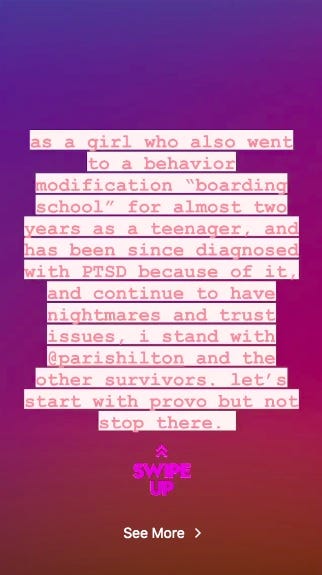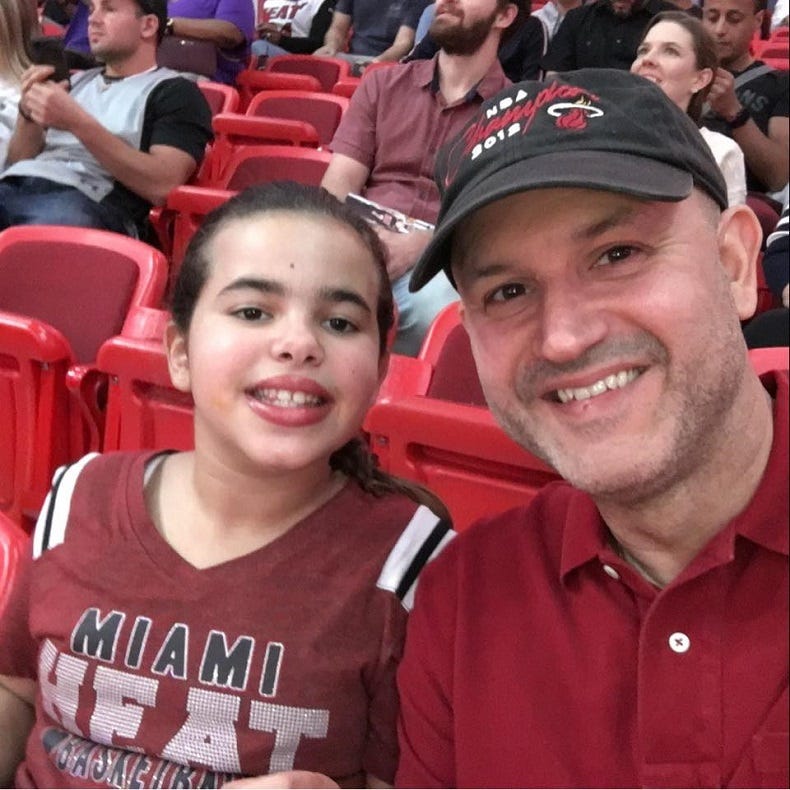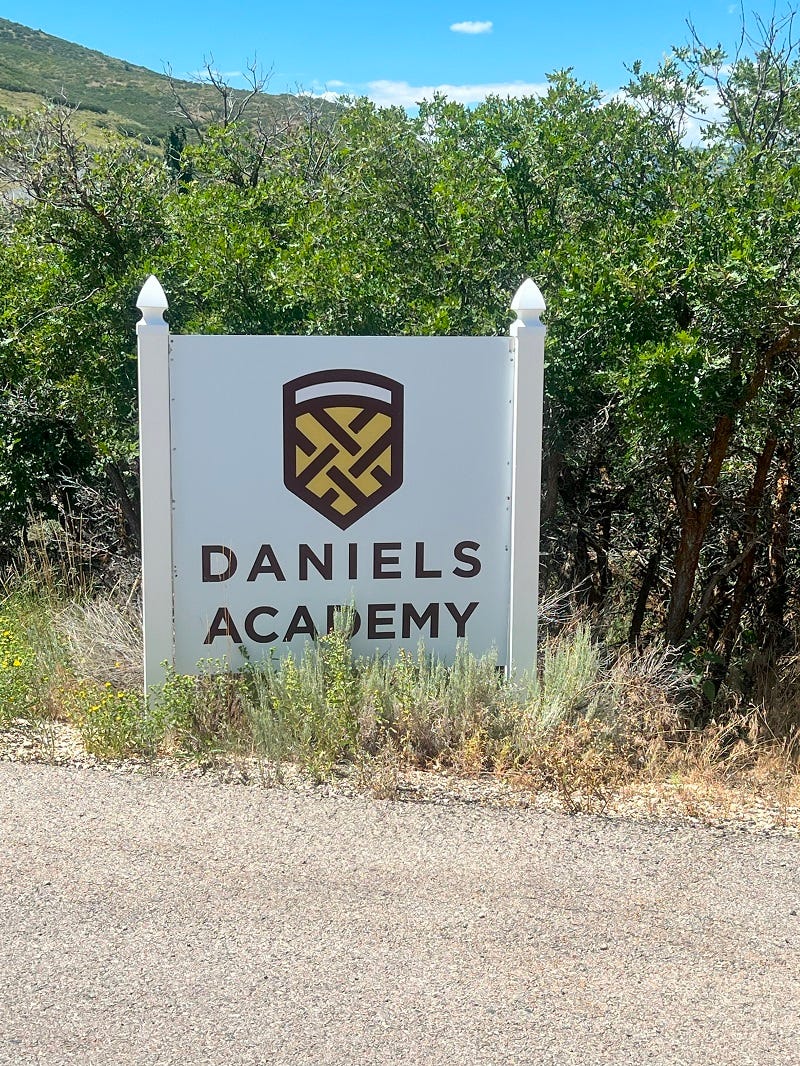“Jump and don’t look back”—three-story suicide is latest in Utah’s troubled teen industry.
Daniels Academy survives but two of its clients did not.

This report discusses suicide. If you or people you know are at risk of self-harm, call or text 988 to reach the Suicide & Crisis Lifeline for 24-hour support.
A condensed version of this article ran under the same byline at The Daily Mail here.
“Jump and don’t look back.”
That was the message a staffer found left behind on Dee Rutzen’s mobile phone last month after the self-identified non-binary 16-year-old fatally leapt three stories.
Deaths like Rutzen’s, increasing in number, have galvanized scrutiny on America’s troubled teen industry, a lucrative group of youth treatment programs and detention centers, long under fire from former clients and their families, advocates, former staffers, other medical professionals and legislators, and, now, from celebrities including Paris Hilton and Paris Jackson.
“How many more kids need to die for progress to be made?” Hilton asked the Utah Senate Judiciary Committee two years before Rutzen’s suicide.
As a child, Hilton was held against her will in several industry programs that she and others say were abusive. For example, Hilton was held at the Provo Canyon School in Provo, Utah, long the subject of a permanent injunction. A federal appeals court affirmed that Provo Canyon and its medical director, acting under color of state law, physically abused children, illegally censored their mail, placed children in solitary confinement and subjected them to illegal polygraphs meant to suppress criticism of the program. (United Health Services, which now owns Provo Canyon School, has repeatedly declined to comment on events during previous ownership.)
Hilton now campaigns to close Provo Canyon School and lends her voice to #BreakingCodeSilence, a wider effort to close and curtail the troubled teen industry.
Jackson, for her part, posted to her Instagram account: “as a girl who also went to a behavior modification 'boarding school' for almost two years as a teenager, and has since been diagnosed with PTSD because of it, and continue to have nightmares and trust issues, i stand with @parishilton and the other survivors. let's start with provo but not stop there.”
Rutzen attended Daniels Academy, in Heber City, Utah, a program targeted for boys on the autism spectrum. According to its website, “Daniels Academy provides a safe and therapeutic environment where young men overcome past failures and learn to thrive through meaningful relationships and coaching.”
Rutzen was the second Daniels Academy teen to die by suicide in the past few years, and the sixth known child in the past four years to die while enrolled at a Utah youth program. Utah does not maintain a comprehensive list of program-related fatalities, but advocates have confirmed 26 such deaths since 1989. (If you have information about an unlisted death at a Utah youth program, please contact MartyG Reports.)
(Daniels Academy was emailed for comment using the address listed on its website and responded with an error message. Previously, The Salt Lake Tribune called Daniels Academy and a staffer declined to comment and hung up. Rutzen’s parents were also emailed and called, but did not respond in time for publication. Rutzen’s obituary is available here; multiple sources, including current and former Daniels Academy staffers, confirm Rutzen’s death at the program.)
“This nightmare has remained an open secret for years,”
said Congressman George Miller, then-chairman of the U.S. House Committee on Education and Labor, during a 2007 hearing entitled Cases of Child Neglect and Abuse at Private Residential Treatment Facilities. “Sporadic news accounts of specific incidents have built a record that should never have been ignored, but shamefully it was, and the federal government has completely failed to grasp the urgency of this situation.”
Months later the U.S. Government Accountability Office, the investigative arm of Congress, presented findings to Miller’s committee during its hearing Child Abuse and Deceptive Marketing by Residential Programs for Teens. The G.A.O. investigated specific instances of neglect and abuse at industry programs nationwide. Its testimony included the following (video below):
One [wilderness program] group became lost and spent several additional hours hiking when the reported heat index outside was 120 degrees [Fahrenheit]. A 14-year-old boy, weighing 250 pounds, had problems breathing, but was encouraged by the staff to continue. When he returned to the camp, he collapsed against a tree and fell to the ground. Staff believed that he was faking it until he vomited, became unresponsive and ultimately died.
A 17-year-old male jumped off of a building in a suicide attempt and severely broke his left arm, with the bone exposed. Despite this severe wound, the boy was punched, slammed against walls and rolled in the dirt. He was beaten so severely that he forgot who he was and he became unconscious. These beatings continued for two weeks before he was finally given medical treatment.
A 16-year-old boy having trouble breathing and walking was tortured and humiliated for days. One staff member told the boy that he deserved an Academy Award for faking it. He died later that day. An autopsy report for this boy showed 71 contusions and abrasions from head to toe.
Another 16-year-old boy with asthma was placed in a face-down restraint by three staff members before he died. Another boy was restrained more than 250 times, including two times for more than 12 hours each. A 12-year-old boy, weighing 87 pounds, was placed in a face-down restraint with a staff member lying on top of him until he died.
And a staffer referred to as the drill instructor trained his pit-bull to bite people in the crotch on command. A 17-year-old boy experienced this painful abuse.[…]
Boys at one boot camp were required to stand with bags over their head[s] and a hangman's noose around their neck[s]. The rope on this noose was tightened to simulate a hanging. The individual responsible for this told officers that this was an appropriate form of discipline.
Another boy was forced to lie face-down on a red ant hill and was not allowed to brush the ants off of his face or his body. In a separate incident, this boy was required to lie on his stomach for 10 hours. He was only allowed to get up to vomit, and then he was required to clean up his vomit before he got down on the ground again.
And finally, the posterboard [see video below] shows [a] picture of a horse in Canada. This horse was starved, as you can see by the protruding rib cage. Neglect also resulted in the problems with the hoof that you see on the picture.[…]
This horse belonged to the owner of one of our case-study programs. This owner was convicted in Canada for cruelty to 39 horses and seven Golden Retrievers.
Although he received a lifetime ban from taking care of animals in Canada, he was allowed to take care of teenagers here in the United States, and the results should not be surprising. He and his wife were cited in Utah for, among many things, use of profane language to humiliate youth, improper seclusion, and rat infestation.
Cases like these led Hilton to testify: “The people who work at, run and fund these programs should be ashamed of themselves.”
“The State of Utah […] has consistently demonstrated its lack of concern for the safety, well-being, and treatment of youth in programs,”
wrote Ricky Dias last month. Dias was the executive director of Diamond Ranch Academy, perhaps Utah’s wealthiest youth residential program. (The Utah Office of Licensing was emailed for comment on Dias’s statement but did not answer by publication.)
Diamond Ranch closed Monday, following 17-year-old Taylor Goodridge’s death five days before last Christmas. Goodridge’s family is suing Diamond Ranch. She was the third teen known to die there.
Diamond Ranch’s website boasted it is “America’s leading teen therapeutic boarding school and clinical residential program, providing a first-class, structured, and supportive campus for boys and girls struggling with emotional, social, educational, or behavioral issues.”
But Diamond Ranch, its medical director Dr. Danny Wormwood and two of its nurses each breached the state’s minimum level of care, harming Goodridge, according to a panel of the Utah Division of Professional Licensing.
For over a week before Goodridge died, the teen vomited. Her blood pressure was low, her heart rate high. The panel found those symptoms required emergency care, which Diamond Ranch withheld. Moreover, Brooks Wiley, a psychiatric nurse practitioner and Diamond Ranch’s assistant medical director, was “not qualified to work in an urgent care, ER, or family practice setting” and “was working beyond the scope of his license” when he treated Goodridge, the panel found.
“Children that become ill at DRA are often ignored or told that they are faking their illnesses,” the Goodridges allege in their civil suit. “Many claim that they are given aspirin and water and told to ‘suck it up.’”

Such allegations abound against industry programs. And, similar to other fatal cases, the Division of Professional Licensing found that some of Goodridge’s physical symptoms could not have been faked and would have led a reasonable medical professional to send her to the E.R.
Goodridge’s death cast uncertainty over Diamond Ranch’s future. But it had already survived when two of its other clients had not. Each time the Utah Department of Health and Human Services Office of Licensing investigated Diamond Ranch and allowed it to stay open. (Utah’s Office of Licensing oversees facilities but not individual doctors and nurses. The Division of Professional Licensing, mentioned further above, is distinct. It licenses individual medical practitioners.)
“If the Office of Licensing determines that the provider is walking in the right direction, our job is not to close them but to support their efforts to become better providers,” the Office of Licensing said in a June 26, 2023, statement, “as long as the health and safety of their clients are not compromised.”
But this time diverse pressures mounted.
On Christmas Eve, four days after Goodridge’s death, Hilton tweeted: “It is vital that facilities like Diamond Ranch Academy are held accountable.” (Hilton’s publicist, Jill Fritzo, wrote that Hilton was not available to comment prior to publication.)

Goodridge’s family remained vocal, in and out of court. Advocates and former D.R.A. clients rallied, sending the Office of Licensing testimonials of abuse and neglect.
Then, in June, Utah’s Disability Law Center, a federally mandated protection and advocacy agency, published a report on Utah’s oversight of inpatient care, including youth programs. It noted: “Time and time again, facilities that mistreat vulnerable residents and fail to provide them with appropriate treatment or even humane living conditions continue to operate.”
On July 11, 2023, The Division of Professional Licensing released its findings, quoted above. The panel members also expressed “hope that the State will investigate Diamond Ranch Academy,” as well as “concerns over the entire industry with residential treatment facilities for adolescents."
Within hours the Office of Licensing declined to renew Diamond Ranch’s license and ordered it to “discharge all of its clients on or before August 14, 2023.”
Though Diamond Ranch had the right to appeal, Dias announced it would close. That may not signify the end, however.
"They can shut down and reopen under a different name to avoid lawsuits,” Jackson told LVR a year earlier, reflecting on industry programs’ past tactics, “and it depends on how state laws work.” (Programs have also closed due to criminal and licensing actions, only for the same staffers to reopen under new names, including in Utah.)
“The decision to cease operations has been spurned[sic] by unfair treatment from the State of Utah,” Dias wrote.
“You don’t know what pain is,”
Maple Lake Academy’s recreational therapist told 14-year-old Sofia Soto, The Salt Lake Tribune reported.
Soto had been vomiting for days. She was autistic and her parents had agonized over placing her at Maple Lake. According to its website, “Maple Lake Academy is a unique program for students with challenges due to Autism Spectrum and/or Social, Emotional and Academic challenges.”
Soto died January 16, 2022. Her parents say they had pleaded with Maple Lake to take her symptoms more seriously. The Office of Licensing found that Maple Lake “failed to provide necessary medical care,” leading to Soto’s death. Utah placed Maple Lake on a kind of probationary licensing but allowed it to stay in business.
A few months later, after a similar but nonfatal incident, the Utah Office of Licensing gave Maple Lake 30 days to close. But Utah relented and Maple Lake remains open today.
The Sotos have sued. (A previous request for information to Gross & Rooney, the family’s law firm, went unanswered.)
“Obviously, this situation is tragic for all involved,” Maple Lake Academy wrote. “It would not be appropriate for us to comment at this time, other than to say that our hearts continue to go out to the Soto family for their loss. We respect the legal process and will act in good faith as we seek resolution.”
“He blew his brains out,”
said Maverick, a former Daniels Academy teen, about his friend Ben Hertzman.
Hertzman was home at the time, on a break from Daniels. His December 26, 2020, suicide was confirmed by Spencer Klausner, then Hertzman’s roommate at Daniels Academy. (Hertzman’s father was called and Facebook messaged for comment. A receptionist said he and his family were on vacation and unavailable. Hertzman’s obituary is here. The Utah Office of Licensing was also emailed for comment about a program-related suicide on December 26, 2020, to which it responded, “An incident was reported and investigated by OL. The facility was found to be in compliance with licensing rules.”)
Hertzman “hated some of the policies that were only enforced when it was convenient for the staff,” Klausner said. “He didn’t like that the treatment team was a dictatorship. He didn’t like the way that certain staff treated him.”
“I think he had a lot of issues with the program,” Klausner said. “And he hid them well enough to fool the staff so they would let him go home.”
“Daniels has a policy before sending kids home for break, to make sure that they are ready to go home and accepting that they will have to come back. He was deemed well enough to go home.”
Asked if Hertzman had ever discussed hiding his feelings from the staff, Klausner said, “No. But most of the students suspected it, because that’s what most of us had to do to progress in the program.[…] I learned that if I wanted anything I had to shut up and keep my head down for long enough. Daniels didn’t prepare you to be your best self. They brainwashed you into being exactly who they wanted you to be.”
“It’s a corrupt organization that is more concerned about profit than genuinely helping its clients,” concluded Klausner. “Because, if they really were focused on helping their clients, they wouldn’t have had two of them kill themselves.”
Maverick, too, raised that last point: “Daniels Academy may play it off as a good facility, but being there for two years has taught me that only one thing mattered. Money.”
One former Daniels Academy staffer and one current staffer were also interviewed. Each spoke on condition of anonymity. Both said Daniels Academy had acted slowly to send children to higher levels of psychiatric care and both suspected financial motives.
"Some kids, once they come through the door,” the current staffer said, “the first thought is they need a higher level of care. This is not going to work out."
Daniels Academy was “not a program designed for kids with a lot of suicidal ideation,” said the former staffer.
The former staffer also said that Rutzen was “very obviously depressed and suicidal when I worked there and it didn't even take a therapist to see that [Rutzen was] not in a good place and I don't know how they ever thought it was a good idea to put [Rutzen] in” an apartment, i.e. under less scrutiny.
The staffers and multiple former clients were asked whether children would have had difficulty jumping three stories from the apartment in which Daniels Academy placed Rutzen. They unanimously answered that no significant physical or supervisory barrier existed.
When asked if Daniels Academy had taken steps since Rutzen’s death to mitigate the chance of another suicide, the current staffer answered, “Not really. No."
Rutzen had been at the program a year a half, said the current staffer.
“Most students didn't really have the ability to talk to their family outside of therapy sessions or talk to friends from home at all,” said the former staffer. “It was hard to see because the kids wanted so badly to just connect with someone they cared about, but they had very few people, and there were so few staff that we couldn't provide them with the adequate attention that they all needed.” (The mobile phone on which Rutzen’s apparent message was found was reportedly a type of phone that allows for tight limiting of communications.)
“Kids saw their families two or three times, maybe five or six, if they were lucky, or their parents had enough money,” the former staffer said. “Outside of those times they had no physical contact with anyone.”
After Rutzen’s suicide, the Office of Licensing placed Daniels Academy on probationary licensing, as it had Maple Lake and Diamond Ranch. That sanction is scheduled to expire August 20. (The Friday before publication, the Heber City Police Department confirmed that it had completed its investigation of Rutzen’s death. The Office of Licensing said that it had yet to receive the police report, its investigation into Daniels Academy remains open, and Daniels Academy was fully cooperating: “It is important to make sure every detail is fully evaluated before the department makes a determination about whether the facility was in compliance with licensing rules.”)
“It breaks my heart,”
Goodridge’s mother, AmberLynn Wigtion, told MartyG Reports, when asked about Rutzen’s and Soto’s deaths. "For any parent, who is considering a residential treatment for their child, I would strongly recommend to dig deep into your research on that facility. My first recommendation would be to try to work out any issues at home."
Nora Ashleigh Barrie coauthored this report. She maintains https://thetroubledteenindustry.com/ and manages The Surviving Abuse Podcast.













I’m also a former student at Daniels and a friend of both Mr. Maverick and Klausner as well as Hertzman and Rutzen, if you want to set up and interview with me, I would be more than happy, the name is Matt Lambright.